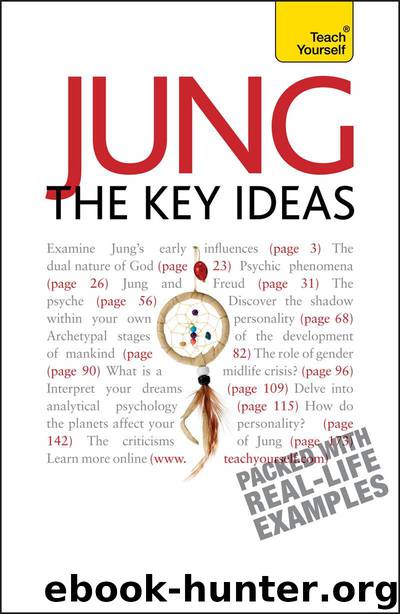Jung- The Key Ideas by Ruth Snowden

Author:Ruth Snowden
Language: eng
Format: azw3
ISBN: 1235827720
Publisher: Hodder & Stoughton
Published: 2010-02-26T05:00:00+00:00
Individuation and the Self
Unlike most psychologists of his day, Jung insisted that the development of the psyche extends well beyond childhood and adolescence, even continuing into old age: we never finish the process of self-examination and growth that charts our journey towards individuation. Jung believed that this process can never become complete unless the individual confronts the monsters that lurk in his own unconscious. He discovered these in his own psyche during his midlife crisis, and they appear throughout myth and legend in archetypal themes such as slaying the dragon.
Jung gave an analogy for the limited way in which most people live out their lives, saying that they only live on one or two floors of a large apartment building, never venturing into the rest. This building represents the psyche, where the unexplored rooms are the vast unexplored areas of the unconscious. Most people totally ignore their unconscious aspects, but if they can learn to listen to the messages that the unconscious brings in their dreams and fantasies, they can use them to enrich and heal their lives. The unconscious conveys these messages in the form of imagery, signs and symbols – it is up to the conscious mind to work with these in productive ways. This is not always easy because, as Jung discovered on his soul journey, the world of the unconscious is confusing and at times frightening.
The first layer that is usually uncovered when we begin to explore the unconscious is the shadow. As we saw in the previous chapter, this is made up of all the parts of ourselves that we don’t really want to look at, or cannot consciously admit to – in other words, the aspects of ourselves that we do not like. The shadow is often projected outwards onto other people or groups of people. It can also be turned inwards and repressed, where it may cause neuroses or other psychic disturbances. Like all psychic elements, the shadow has both negative and positive aspects – the negative aspect can show us the darker sides of the personality and things that we need to work on. The positive aspect can show us qualities in ourselves that we have not acknowledged and which can be very empowering. Jung said that his own shadow was huge, and it was too big a task to tackle the whole of it in one lifetime. All he could do was to look at it and try to take responsibility for it.
Taking responsibility for our less favoured aspects is the first task of the Self in the individuation process. Throughout this process, the psyche has to continually examine and confront what it produces. In terms of Jung’s own two conflicting personalities, we could say that analytical, conscious personality Number 1 is continually looking at and trying to understand unconscious personality Number 2, which is always sending messages to try and get Jung’s attention. The work is not easy, as Jung himself admitted, but it can have great rewards as it helps us to become more peaceful humans, better able to relate effectively to our fellow beings.
Download
This site does not store any files on its server. We only index and link to content provided by other sites. Please contact the content providers to delete copyright contents if any and email us, we'll remove relevant links or contents immediately.
Rewire Your Anxious Brain by Catherine M. Pittman(17589)
Talking to Strangers by Malcolm Gladwell(11879)
The Art of Thinking Clearly by Rolf Dobelli(8842)
Mindhunter: Inside the FBI's Elite Serial Crime Unit by John E. Douglas & Mark Olshaker(7834)
Becoming Supernatural by Dr. Joe Dispenza(7106)
Change Your Questions, Change Your Life by Marilee Adams(6641)
The Road Less Traveled by M. Scott Peck(6635)
Nudge - Improving Decisions about Health, Wealth, and Happiness by Thaler Sunstein(6633)
The Lost Art of Listening by Michael P. Nichols(6474)
Enlightenment Now: The Case for Reason, Science, Humanism, and Progress by Steven Pinker(6405)
Win Bigly by Scott Adams(6312)
Mastermind: How to Think Like Sherlock Holmes by Maria Konnikova(6236)
The Way of Zen by Alan W. Watts(5800)
Daring Greatly by Brene Brown(5641)
Grit by Angela Duckworth(4737)
Big Magic: Creative Living Beyond Fear by Elizabeth Gilbert(4723)
Men In Love by Nancy Friday(4326)
Flow by Mihaly Csikszentmihalyi(4052)
The Four Tendencies by Gretchen Rubin(4024)
